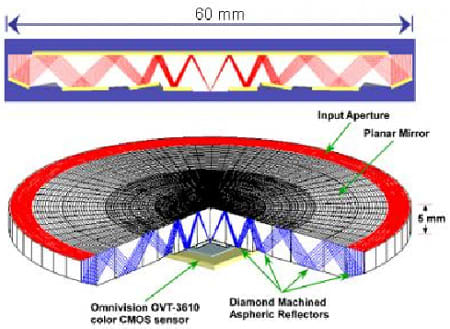UCSD Develops High Resolution Camera with Folded Origami Lens
UCSD developed a high resolution compact camera with a folded telephoto lens, using diamond turning. Could be applied to defense and cell phones.
Recommendations are independently chosen by Reviewed's editors. Purchases made through the links below may earn us and our publishing partners a commission.
*February 5, 2007 *– Engineers at the University of California San Diego announced last week that they have developed an annular folded optic imager, or an "origami lens," according to a Feb. 1 UCSD press release. The researchers developed a prototype for the high resolution camera, which holds a folded telephoto lens to maintain a small body size. With this new technology, the camera could have defense applications or even be applied to camera phones, said senior author of the abstract Joseph Ford in an interview with DigitalCameraInfo.com.
"This will allow telephoto cameras to come in smaller packages," said UCSD Associate Professor Joseph Ford of the Jacobs School of Engineering.
UCSD engineers Ford and first author Eric Tremblay and optical systems company Distant Focus Corporation Ron Stack and Rick Morrison have been working on the annular folded optic imager prototype for three years now. It is based on telescope technology dating as far back as 1672, according the release.
This "exotic technology," as Ford called it, allows users to capture high resolution images with a compact camera using a different method than traditional cameras. The UCSD engineers replaced the traditional lens with reflective elements folded on top of one another to reduce the thickness of the optical system.
Using a method called "diamond turning," UCSD engineers cut a series of reflective surfaces onto 5mm of a disk of calcium fluoride with the tip of a diamond. Light travels through a round aperture, bouncing between two 60mm reflective surfaces in a "Z" manner, explained Ford, eventually hitting the CMOS sensor. Unlike standard cameras in which light bounces only twice, the annular folded optic imager allows light to bounce 8 times.
The engineers tested the resolution results against an SLR camera and a Canon SD40 point-and-shoot. The folded imager performed close to the SLR in terms of resolution and outperformed the point-and-shoot model, according to Ford. With this technology, researchers can increase focal length without adding more distance between the lens and the sensor, keeping the camera compact.

Funded by the U.S. Department of Defense Advanced Research Projects Agency (DARPA), the annular folded optic imager, or origami lens, could have potential defense applications, although Ford could not give details.
On a consumer level, the technology could be applied to the everyday cell phone. Comparing the size of the camera to an iPod Nano, the annular folded optic imager could maintain the size of mobile phone while supplying a high resolution imager.
"We’ve done the research. We have a design; we’ve tested it. It works," said Ford. "The concern is with manufacturing," he said. With hopes and time, consumers may someday be able find the technology outside the lab and into their pockets.
Interested readers can find the UCSD press release at http://ucsdnews.ucsd.edu/newsrel/science/foldedlens07.asp.
Images courtesy of University of California San Diego.

